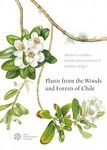![Guide Illustré de la Flore de Patagonie [Illustrated Guide to the Flora of Patagonia] Guide Illustré de la Flore de Patagonie [Illustrated Guide to the Flora of Patagonia]]()
Click to have a closer look
About this book
Customer reviews
Related titles
Recommended titles
About this book
Language: French
Shared between Argentina and Chile at the southern tip of the American continent, Patagonia has long fascinated explorers, naturalists and simple travelers. Depending on altitude, exposure to wind and precipitation, or latitude, this vast, sparsely populated area has a wide variety of habitats and a diverse flora. Between the Andean-Patagonian temperate forest, the rainy Valdivian forest, the sub-Antarctic forest, the steppes, and the high vegetation of high altitude, the flora of Patagonia is at the same time varied and original. According to the regions, it has affinities with the flora of the rest of South America, North America, but also with that of Oceania, especially New Zealand, and it also shows a high rate of endemism.
Translated and expanded from a first bilingual edition (Spanish / English) published in 2008 (Vázquez Mazzini Editores), this naturalist guide offers the non-specialist a presentation of the most characteristic botanical families of Argentine and Chilean Patagonia. A total of 95 families are described, with the main genera and species, their specific habitat, and each family being illustrated by one or more species, mostly indigenous. Discover the amazing botanical wealth of the southernmost region of the world, with its original and still little known flora.
Summary in French:
Partagée entre l’Argentine et le Chili à la pointe australe du continent américain, la Patagonie a de longue date fasciné explorateurs, naturalistes et simples voyageurs. Selon l’altitude, l’exposition aux vents et aux précipitations, ou selon la latitude, ce vaste espace peu habité présente une grande variété de milieux et une flore diversifiée. Entre forêt tempérée andino-patagone, forêt valdivienne pluvieuse, forêt subantarctique, steppes, végétations rases de haute altitude, la flore de Patagonie est à la fois variée et originale. Selon les régions, elle présente des affinités avec la flore du reste de l’Amérique du Sud, de l’Amérique du Nord, mais également avec celle de l’Océanie, et notamment de la Nouvelle-Zélande, et elle montre par ailleurs un taux important d’endémisme.
Traduit et augmenté à partir d’une première édition bilingue (espagnol/anglais) publiée en 2008 (éditions Vázquez Mazzini Editores, Buenos Aires), ce guide naturaliste offre au non-spécialiste une présentation des familles botaniques les plus caractéristiques de la Patagonie argentine et chilienne. Au total 95 familles sont décrites, avec les principaux genres et espèces, leur habitat spécifique, chaque famille étant illustrée par une ou plusieurs espèces, le plus souvent indigènes. Une invitation à la découverte de l’étonnante richesse botanique de la région la plus australe du monde, avec sa flore originale et encore mal connue.
Customer Reviews





![Guide Illustré de la Flore de Patagonie [Illustrated Guide to the Flora of Patagonia] Guide Illustré de la Flore de Patagonie [Illustrated Guide to the Flora of Patagonia]](http://mediacdn.nhbs.com/jackets/jackets_resizer_xlarge/24/246157.jpg?height=620)
![Guide Illustré de la Flore de Patagonie [Illustrated Guide to the Flora of Patagonia]](http://mediacdn.nhbs.com/jackets/jackets_resizer/24/246157.jpg)





![Árvores Brasileiras, Volume 1: Manual de Identificação e Cultivo de Plantas Arbóreas Nativas do Brasil [Brazilian Trees, Volume 1: Identification and Cultivation Manual of Native Brazilian Arboreal Plants]](http://mediacdn.nhbs.com/jackets/jackets_resizer_medium/25/255528.jpg?height=150&width=102)



![Gramineas de Bolivia [Gramineas of Bolivia]](http://mediacdn.nhbs.com/jackets/jackets_resizer_medium/81/81508.jpg?height=150&width=94)




![Costa Rica: Tropical Flowers [English / Spanish]](http://mediacdn.nhbs.com/jackets/jackets_resizer_medium/19/195410.jpg?height=150&width=64)

![Árvores Brasileiras, Volume 3: Manual de Identificação e Cultivo de Plantas Arbóreas Nativas do Brasil [Brazilian Trees, Volume 3: Identification and Cultivation Manual of Native Brazilian Arboreal Plants]](http://mediacdn.nhbs.com/jackets/jackets_resizer_medium/25/255530.jpg?height=150&width=103)


![Lézards, Crocodiles et Tortues d’Afrique Occidentale et du Sahara [Lizards, Crocodiles and Turtles of West Africa and the Sahara]](http://mediacdn.nhbs.com/jackets/jackets_resizer_medium/21/210753.jpg?height=150&width=97)


![Guide des Serpents d'Afrique Occidentale, Centrale et d'Afrique du Nord [Guide to Snakes of West, Central and North Africa]](http://mediacdn.nhbs.com/jackets/jackets_resizer_medium/26/262123.jpg?height=150&width=94)
![L'Acacia au Sénégal [The Acacia in Senegal]](http://mediacdn.nhbs.com/jackets/jackets_resizer_medium/96/96033.jpg?height=150&width=96)
![Nouvelle-Calédonie: Archipel de Corail [New Caledonia: World of Corals]](http://mediacdn.nhbs.com/jackets/jackets_resizer_medium/24/247969.jpg?height=150&width=170)

![Biogéographie de la Flore du Sahara: Une Biodiversité en Situation Extrême [Biogeography of the Flora of the Sahara: Biodiversity under Extreme Conditions]](http://mediacdn.nhbs.com/jackets/jackets_resizer_medium/24/243939.jpg?height=150&width=98)

